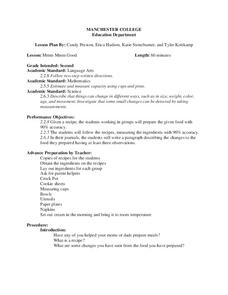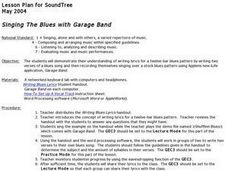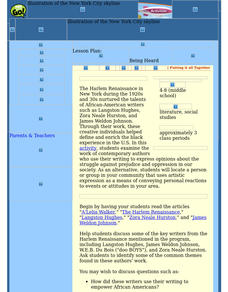Curated OER
All About Seeds!
First graders learn all about seeds. For this biology lesson, 1st graders discover: what a fruit is, what is inside of seeds, and how seeds are transported.
Curated OER
Seasons of Trees
Students examine how trees change over time. In this forestry activity, students read the book The Seasons of Arnold's Apple Tree and choose three trees to observe over a period of time. Students record observations and seasonal changes...
Curated OER
Grouping Fruits and Vegetable
Learners identify the differences between fruits and vegetables. In this nutrition lesson, students identify the properties of fruits and vegetables and group various fruits and vegetables into categories.
Curated OER
Understanding Nouns
Students define what singular and plural nouns mean. In this nouns lesson, students complete a worksheet converting from singular to plural and recognizing the plural forms of nouns.
Curated OER
The Journey of the Magi
Students create storyboards. In this pre-Christmas special lesson, students produce a storyboard for a TV version of the poem, "The Journey of the Magi". Options to complete with or without technology are included.
Curated OER
Beginning with Bosch
Students explore surrealism through the artwork of Hieronymus Bosch. In this surrealism instructional activity, students understand the characteristics of the art of Bosch and create an original artwork and poem to go with it.
Curated OER
A is for Area, B is for Billion
Students interact with math terminology in preparation for standardized assessment. In this math terminology and online storybook lesson, students create their own booklets of math terms based on each letter of the alphabet. Over the...
Curated OER
Science: Changes in Matter
Second graders discover what changes occur in various types of matter under different conditions. They make predictions about the changes in an apple left out in the air, water placed in a freezer, and a nail left in a cup of water. They...
Curated OER
Mummy Madness
Students create a mummy using the mummification process. In this mummy lesson, students peel an apple and place the peeling in a baby food jar. They carve a face into their apple, dry it in salt and wrap it in toilet paper to bury.
Alabama Learning Exchange
Learning the Three Layers
Students examine the Earth's crust or lithosphere, mantle and core. They complete research using assigned web sites before designing a model of the Earth using items such as Play-Doh, peaches and apples.
Curated OER
Golden Ratio
Tenth graders investigate the Golden Ratio. For this geometry lesson, 10th graders explore the Fibonacci sequence in the context of The Fibonacci Rabbit problem. Students examine how the ratio of two consecutive Fibonacci number create...
Curated OER
Worms: Nature's Recyclers
Students explore vermi-composting. For this vermi-composting lesson, students listen to the story Diary of a Worm and discuss the parts of a worm. They create worm bins and add organic food for the worms to recycle.
Curated OER
Mmm Mmm Good
Second graders follow a recipe. In this cooking lesson, 2nd graders are given a recipe and ingredients to prepare food. Students will reflect on their experience in their journals.
Curated OER
Singing The Blues with Garage Band
Young scholars demonstrate writing lyrics for a twelve-bar blues pattern by writing two verses of a blues song and then recording themselves singing over a stock blues pattern using Apple's Garage Band. Requires a networked keyboard lab.
Curated OER
Language Arts, Word Choice
Third graders practice replacing words in a sentence to make it more interesting. In this word choice lesson, 3rd graders listen to the story The Hard-Times Jar by Ethel Smothers and discuss the author's word choice. Students then...
PBS
Being Heard
Examine the work of contemporary authors who use their writing to express opinions about the struggle against prejudice and oppression in our society. A short lesson on the Harlem Renaissance introduces learners to the most prominent...
Curated OER
Horsing around with Verbs
Young scholars identify verbs in complete sentences. In this grammar and locomotor skill lesson, students rotate between ten stations, each with a designated sentence to be read. Young scholars identify the action verb in the sentence...
Curated OER
Cinnamon Ornaments
Students create cinnamon ornaments. In this ornament making lesson, students use applesauce, cinnamon and glue to make ornaments. Students use glitter beads, sequins and other art supplies to decorate the ornaments
Curated OER
A Bug's Life: Diary of an Insect's Metamorphosis
Fifth graders examine the stages of insect's to understand heredity. For this inherited traits lesson, 5th graders explore the life of the honeybee for its inherited traits. Students recognize the difference between inherited traits and...
Curated OER
Creeping and Crawling Observing Mealworms and Earthworms
Students observe the inherited traits in earthworms and mealworms. In this organisms activity, students view a live mealworm and earthworm on a tray and identify the body parts. Students measure the worms and observe the behavior....
Curated OER
Soaring With Air Power
Fourth graders view a Newton's Apple show that explores glider mechanics, explore the four forces, build and fly a glider to specific guidelines. They adjust the glider for greater accuracy and distance using four forces, and assess...
Curated OER
Using Descriptive Language
Students explore the technique of descriptive writing. As a class, they observe a poster and describe it using adjectives. They discuss how descriptive words can be used literally and figuratively in the world of advertising. After...
Curated OER
Finite State Machines
Students observe the programming of a computer. In this technology lesson, students analyze the finite state machine and observe it in motion. This assignment requires the teacher to be specific with the students and the assignment.
Curated OER
Learning About Pointillism
Students read a biography about George Seurat and examine the Pointillism style of painting. They create Pointillism style paintings of apples and consider how the viewer's eye mixes color in the interpretation of the painting.

























